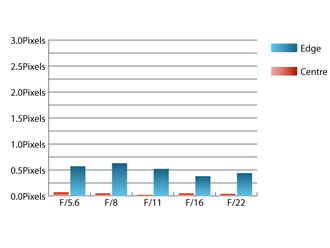Olympus M.Zuiko Digital ED 40-150mm f/4.0-5.6 Lens
Olympus M.Zuiko Digital ED 40-150mm f/4.0-5.6: Performance
Shooting wide open at 40mm, sharpness in the centre of the frame is excellent, and the clarity towards the edges of the frame is fair. Stopping down the lens improves sharpness towards the edges, with the best compromise for sharpness across the frame being achieved between f/5.6 and f/8, where the centre is still excellent, and the clarity towards the edges reaches good levels.Zooming to 70mm maintains the excellent centre sharpness at wide open aperture and the clarity towards the edges is improved over that at 40mm, reaching very good levels at maximum aperture. Again, peak quality across the frame is achieved at f/5.6, where sharpness is excellent across the frame.
Finally at 150mm, sharpness levels drop a little across the frame at maximum aperture, but remain very good in the centre whilst approaching good levels towards the edges. There is little difference in edges sharpness with the lens stopped down, although sharpness in the centre does reach excellent levels at f/8 at this focal length.
Resolution at 40mm | Resolution at 70mm | |
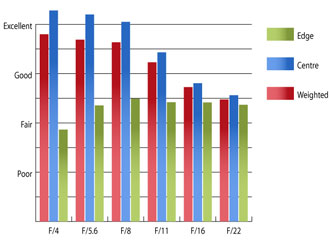 | 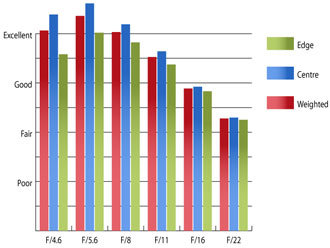 | |
Resolution at 150mm | How to read our chartsThe blue column represents readings from the centre of the picture frame at the various apertures and the green is from the edges. Averaging them out gives the red weighted column.The scale on the left side is an indication of actual image resolution. The taller the column, the better the lens performance. Simple. For this review, the lens was tested on an Olympus PEN E-PL1 using Imatest. | |
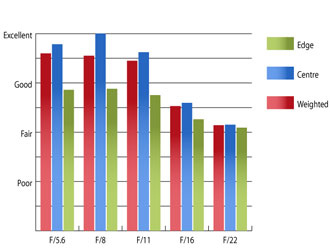 |
Levels of Chromatic aberrations are very low for a telephoto optic such as this. A their worst fringing approaches 0.75 pixels widths towards the edges at 40mm and maximum aperture. This is still a very low level, which should pose few issues, even in large prints or harsh crops from the edges of the frame.
Chromatic Aberrations at 40mm | Chromatic Aberrations at 70mm | |
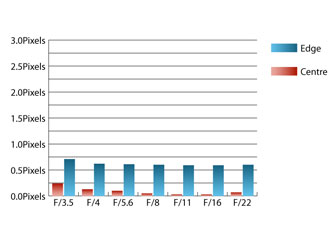 | 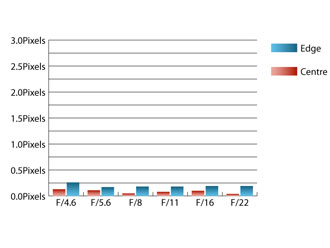 | |
Chromatic Aberrations at 150mm | How to read our chartsChromatic aberration is the lens' inability to focus on the sensor or film all colours of visible light at the same point. Severe chromatic aberration gives a noticeable fringing or a halo effect around sharp edges within the picture. It can be cured in software.Apochromatic lenses have special lens elements (aspheric, extra-low dispersion etc) to minimize the problem, hence they usually cost more. For this review, the lens was tested on an Olympus PEN E-PL1 using Imatest. | |
| |
Falloff of illumination towards the corners is well controlled. At 40mm the corners are only 0.5 stops darker than the image centre at maximum aperture and this level increases to 0.8 stops at 150mm. Stopping the lens down just one stop results in visually uniform illumination throughout the zoom range.
Olympus Micro Four Thirds compatible cameras automatically correct distortion in camera, so the following won't be noticeable if shooting JPEG images, or if the software supplied with the camera is used to convert the RAW images. For a lens with a zoom range over three times, distortion is very well controlled at both ends of the zoom range. Imatest detected 2.8% barrel at 40mm and 0.5% pincushion distortion at 150mm, which are both very mild levels. The distortion pattern is uniform across the frame, so correcting this in image editing software afterwards should be a straightforward affair.
Although this lens isn't supplied with a hood, it is quite resistant to flare and loss of contrast in contra-lit situations. In extreme circumstances strong sources of light just outside of the frame might cause a little flare, and shooting into very strong light sources may result in a slight loss on contrast.
Add your message
Login required
Please login here or if you've not registered, you can register here. Registering is safe, quick and free.
Please login here or if you've not registered, you can register here. Registering is safe, quick and free.
photodo Stats
1102 lenses
428 MTF tests
74 in-depth photodo reviews
100+ users join each day
Help the lens community by reviewing or rating a lens today via our lens search
428 MTF tests
74 in-depth photodo reviews
100+ users join each day
Help the lens community by reviewing or rating a lens today via our lens search
Latest Lens Reviews
- Chinon 28mm f/2.8 Vintage Lens Review
- Canon EF 70-200mm f/4L IS II USM Lens Review
- Samyang AF 85mm f/1.4 EF Review
- Sigma 70mm f/2.8 DG Macro Art Review
- Samyang AF 24mm f/2.8 FE Review
- Meike 50mm f/1.7 Review
- Tamron 70-210mm f/4 Di VC USD Review
- Lensbaby Burnside 35mm f/2.8 Review
- Asahi Super Takumar 50mm f/1.4 Review
- Asahi Super-Multi-Coated Takumar 135mm f/3.5 Review
